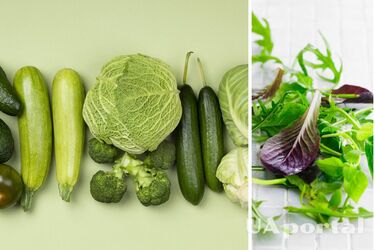Don't avoid green vegetables: what is their power

To meet your basic essential nutrient needs, you need to eat more than 300 grams of greens and green vegetables every day.
Green foods are the benchmark for the balance between being rich in the full spectrum of the most beneficial nutrients and having a minimum number of calories.
However, regularly including such foods in menus remains a challenge for many people. The main obstacles are that greens do not last long, even in the refrigerator, and some people do not like the bitterness and texture of the products.
Technologically processed foods and dishes that are classic representatives of the "Western diet" compete with green vegetables, having a significant head start in terms of ease of preparation and the presence of dominant flavors.
It is also worth recognizing that many people lack the skills to prepare delicious dishes based on a lot of greens and green vegetables.
SPECTRUM OF NUTRIENTS
The above-mentioned unique balance between high nutritional value and minimal caloric content in green vegetables is provided by the content of the following components:
Fiber (plant dietary fiber). All whole plant foods contain fiber. These are simply carbohydrates that are not digested. The fiber in green leafy vegetables is fuel for the beneficial bacteria in our intestines, promotes normal digestion and healthy metabolism.
Vitamins. Dark leafy green vegetables contain many vitamins, especially folic acid and vitamin K. Folic acid, or vitamin B9, is an important nutrient during preconception and pregnancy, contributing to successful conception, gestation and the birth of a healthy baby. Vitamin K is an important nutrient for blood clotting.
Minerals. Green vegetables provide calcium, magnesium and potassium, which help maintain an alkaline pH in the body. Greens are also a plant source of iron.
Phytonutrients. Dark leafy greens contain thousands of phytonutrients, or plant nutrients, that span the entire spectrum of the rainbow. We cannot see most of the colors because the green chlorophyll in plants masks other compounds. For example, leafy greens are a source of red, orange, and yellow carotenoids, which act as antioxidants, reduce inflammation, and support reproductive health. If you've seen kale turn yellow, it's because chlorophyll is breaking down, and carotenoids are showing up underneath.
HEALTH BENEFITS
Green leafy vegetables are associated with the following benefits:
Reduced risk of non-communicable diseases. Eating vegetables (and fruits) is associated with a reduced risk of heart disease, cancer, diabetes, and premature death. The total volume and quantity of vegetables eaten, as well as their variety, are important.
More efficient neutralization and elimination of metabolic end products. Chlorophyll can bind to toxins and carcinogens in the body and help remove them. Vitamins, minerals, and phytonutrients found in green vegetables support liver detoxification. For example, sulforaphane (a sulfur-rich phytonutrient found in broccoli sprouts, kale, and other cruciferous vegetables) plays an important role in liver detoxification. In addition, sulforaphane activates the production of antioxidants that protect against harmful compounds.
Immune health. Many green vegetables contain nutrients necessary for strengthening the immune system, including vitamin C, B vitamins, minerals and antioxidants. In addition, eating vegetables supports a healthy gut microbiome, which directly interacts with the immune system.
Slowing down aging. Phytonutrients and antioxidants are anti-aging compounds associated with healthy aging. Just 200 grams of green vegetables per day slows down the cognitive decline associated with aging.
Improving mineral status. Today, we have an increased need for minerals due to stress, toxins, processed foods, and other factors. Consuming plenty of dark leafy green vegetables is one strategy to improve mineral supply. They contain a lot of magnesium, calcium and potassium: these are electrolytes or alkaline minerals that support mineral balance and homeostasis.
Psychological comfort and better quality of life. Vegetable consumption is also important for psychological health. Several studies have linked eating a large variety of vegetables to happiness, overall well-being, and improved quality of life.
LIST OF GREEN FOODS
Dark green leafy vegetables and greens include alfalfa, arugula, asparagus, beetroot, bok choy (Chinese kale), broccoli, cilantro, chard, chlorella, leaf cabbage, kale, nettle, parsley, wheat sprouts, romaine lettuce, seaweed, spinach, spirulina, turnip greens, watercress, etc.
HOW MUCH TO EAT AND HOW TO INCREASE CONSUMPTION
It is recommended to consume at least five servings of fruits and vegetables (about 500 g) daily, including 300+ grams of vegetables per day. Research shows that in the case of vegetables, the more you eat, the better. A serving is approximately 100 grams of raw vegetables or 75 grams of cooked vegetables.
One good rule of thumb is to choose a variety of green vegetables. Instead of buying the same green products from the store every week, try picking up different ones each time. When you add more variety to your meals, you increase the amount of nutrients and phytonutrients, and therefore the benefits of them.
How to add more vegetables and greens to your daily menu:
Set a realistic goal. It can be difficult to go from a few servings of green vegetables a week to several a day. Start by adding just one serving of greens each day to what you already eat. And then gradually increase the amount.
Use convenient options. If you're busy and don't like to sort through and wash fresh greens, choose pre-washed, chopped, or frozen options.
Make vegetables tasty. A simple solution is to sauté the greens in fat, such as ghee, olive oil, or coconut oil. Add some onions, garlic, and sea salt. Combining greens with fat increases the absorption of fat-soluble vitamins and phytonutrients. Greens are healthier and tastier with fat.
Grow your own herbs. All you need is some fertile soil and seeds. You can grow parsley, cilantro, or spinach at home. Involving children in the process is a great way to teach them to eat more green foods.
Don't ignore vegetables grown in a greenhouse. They may not taste as good as their outdoor-grown counterparts in their season and may contain a bit more nitrates. At the same time, greenhouse green vegetables are almost identical to seasonal ones in terms of the content of the most beneficial nutrients.

